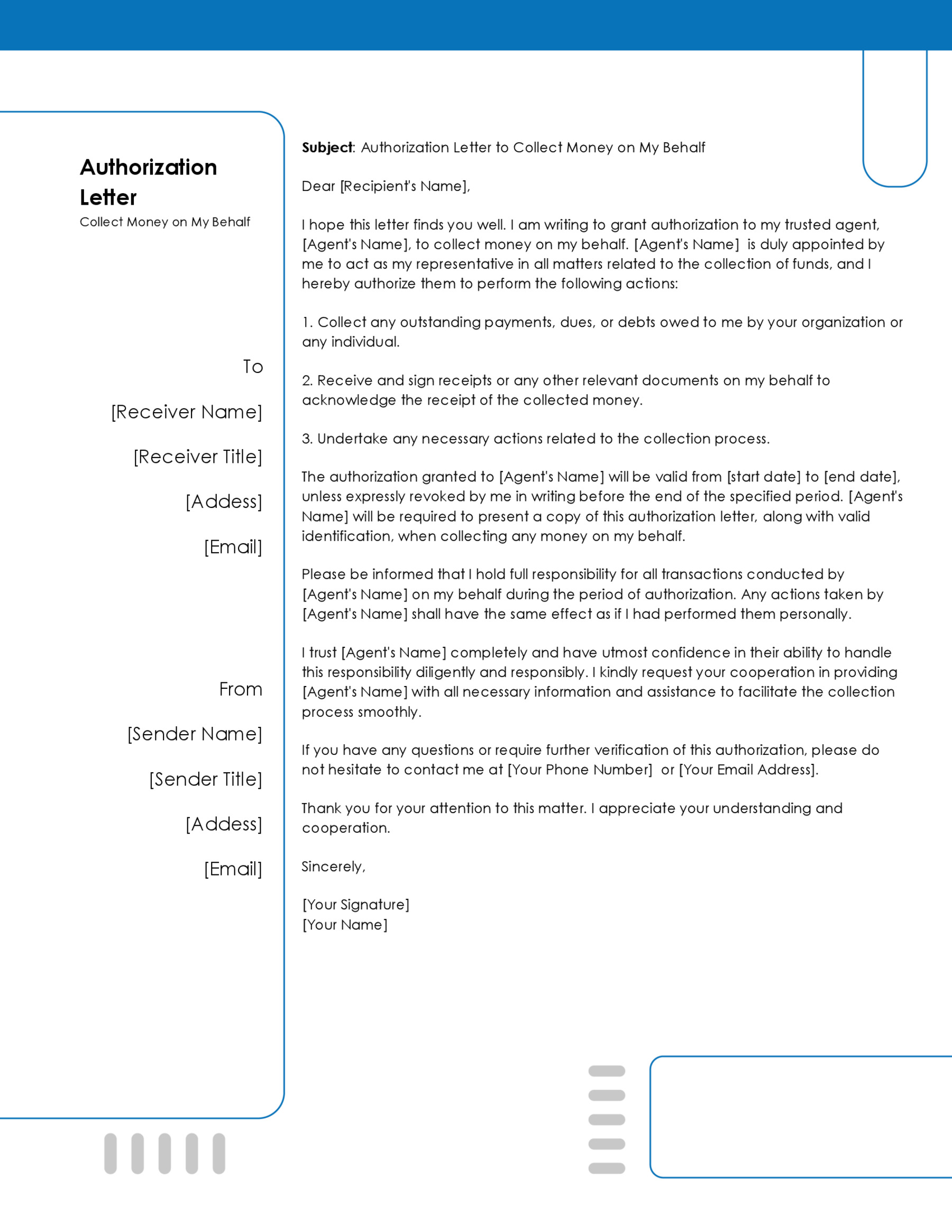Software engineer cover letter is used by applicants for a software engineer position to highlight the value and reasons why they are suited for the position.
This letter is customarily one page long and is submitted during the application.
In some cases, the cover letter can be a requirement of the application. However, in other cases, it will be up to the applicant to take the initiative to submit one unless it is strictly stated not to. Now, why write a software engineer cover letter? These letters are an opening for you to sell yourself to the hiring manager in a more detailed manner than a resume. It states the position the applicant is applying for, reasons why they are interested in that position, and the overall skills they bring to the organisation.
Sample Letters
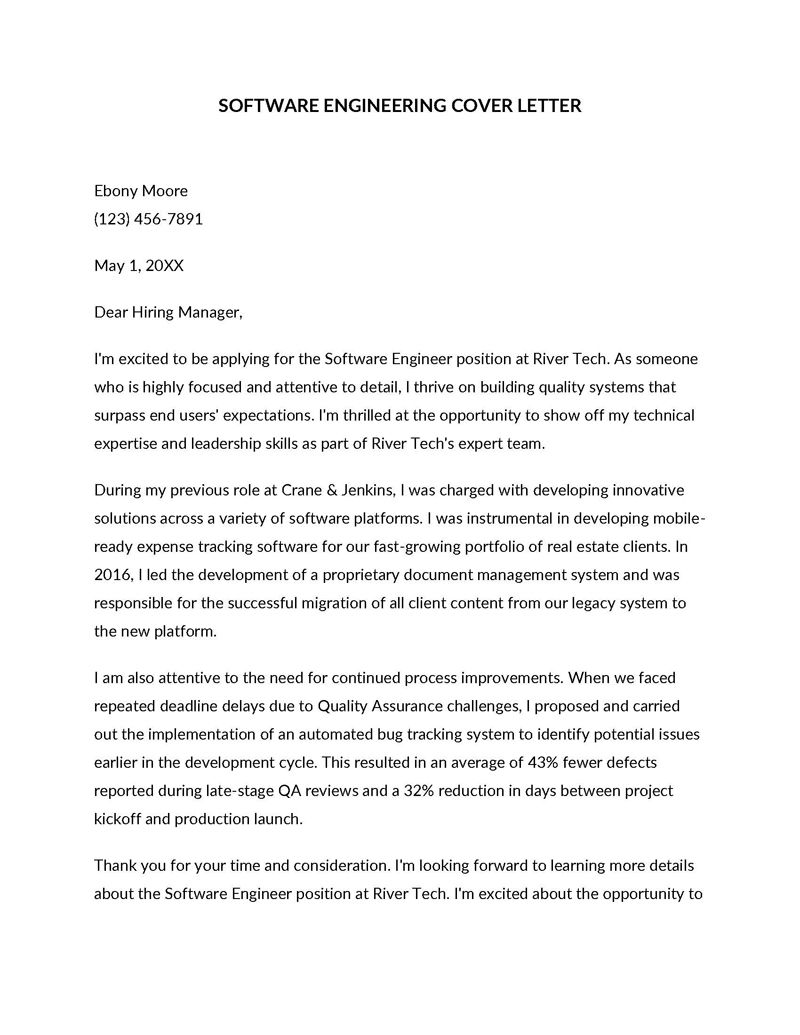
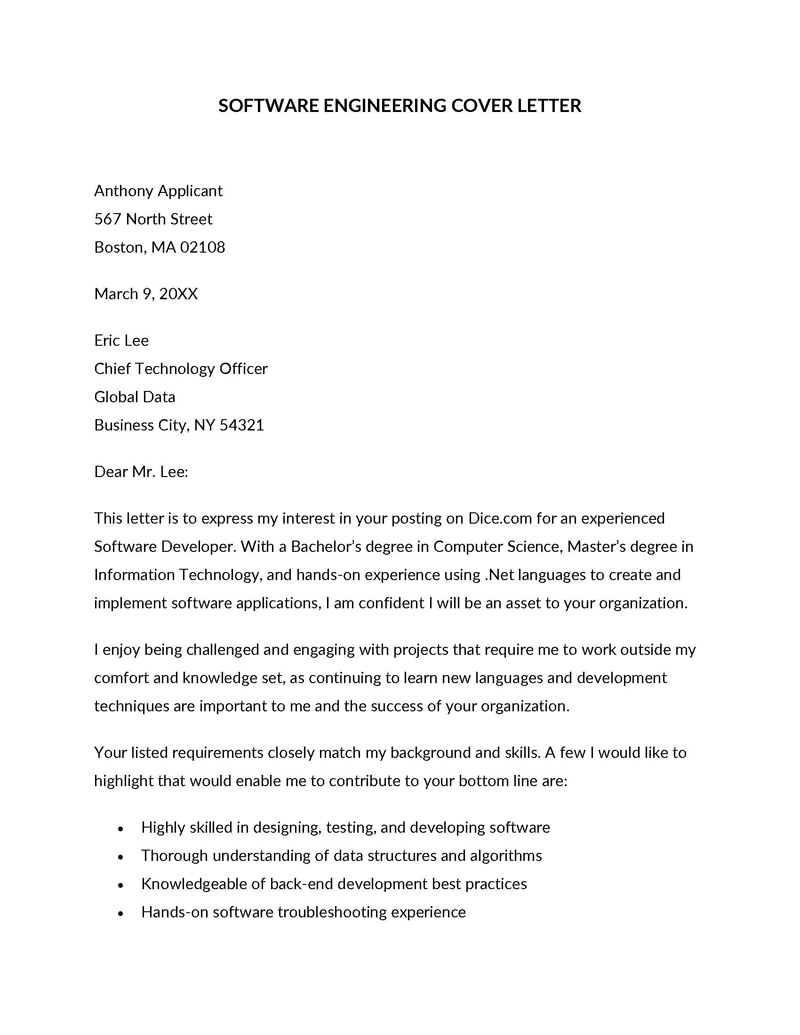
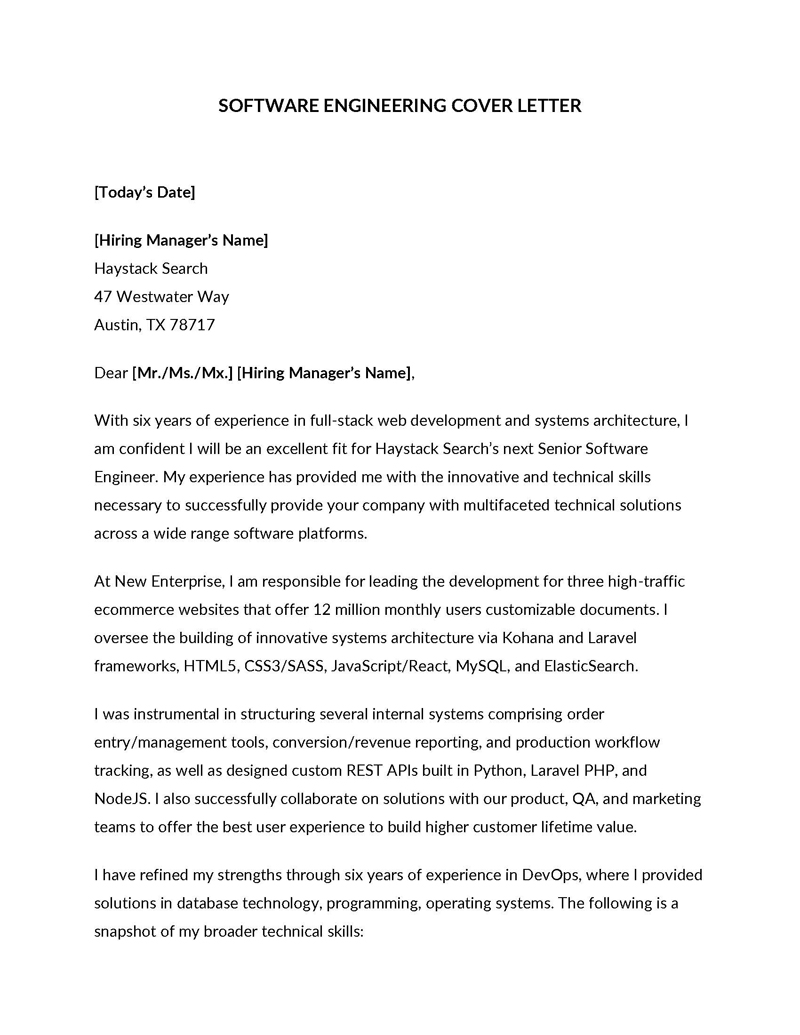
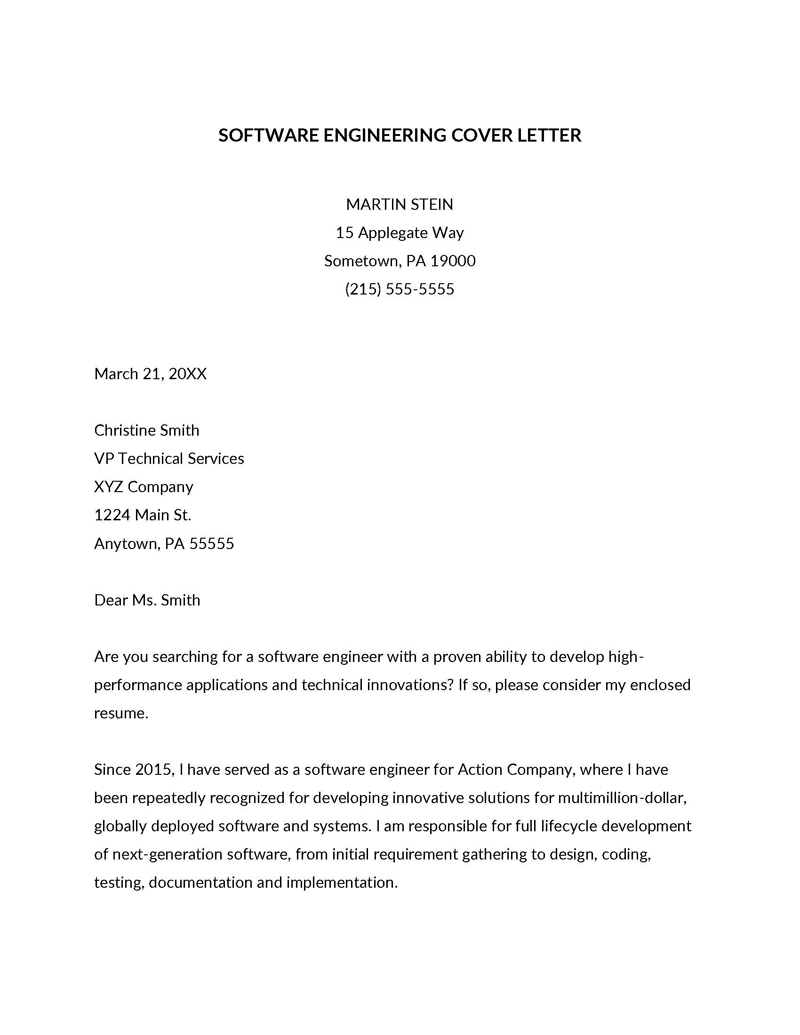
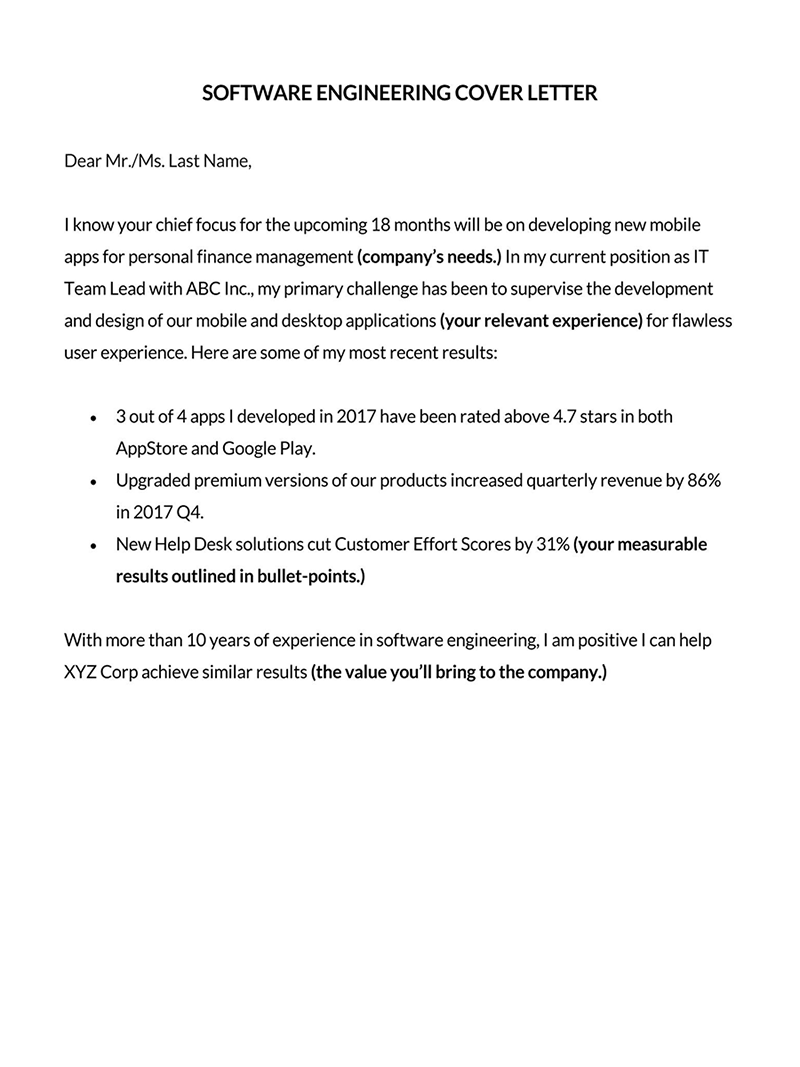
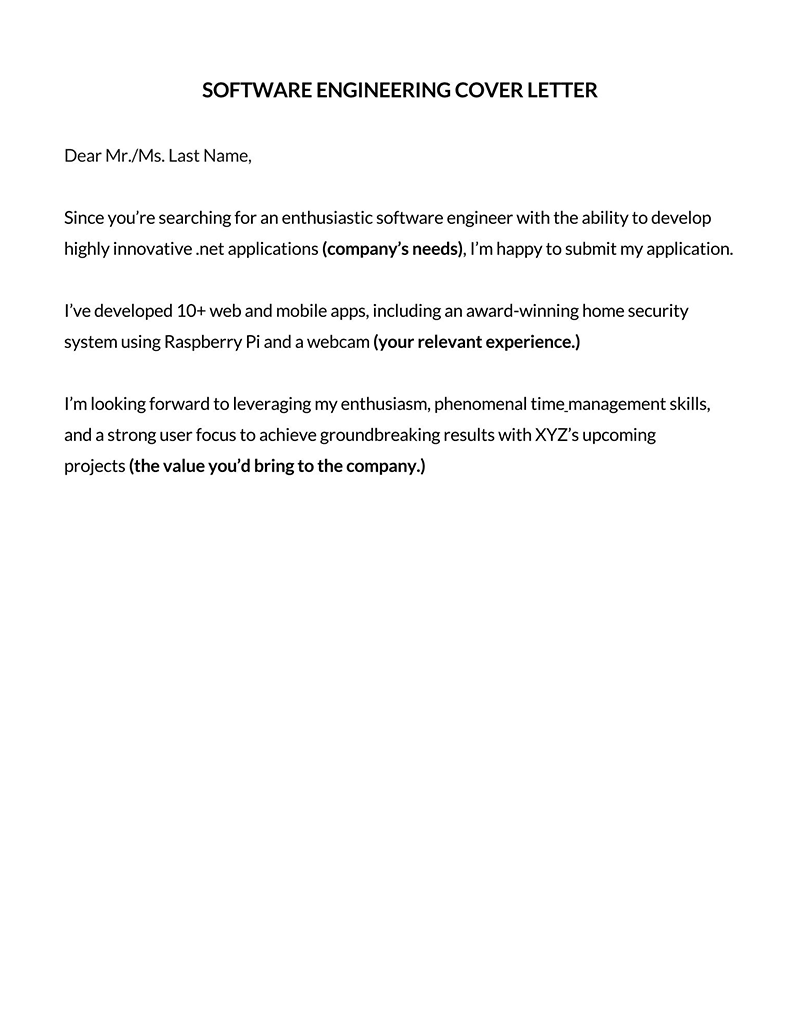
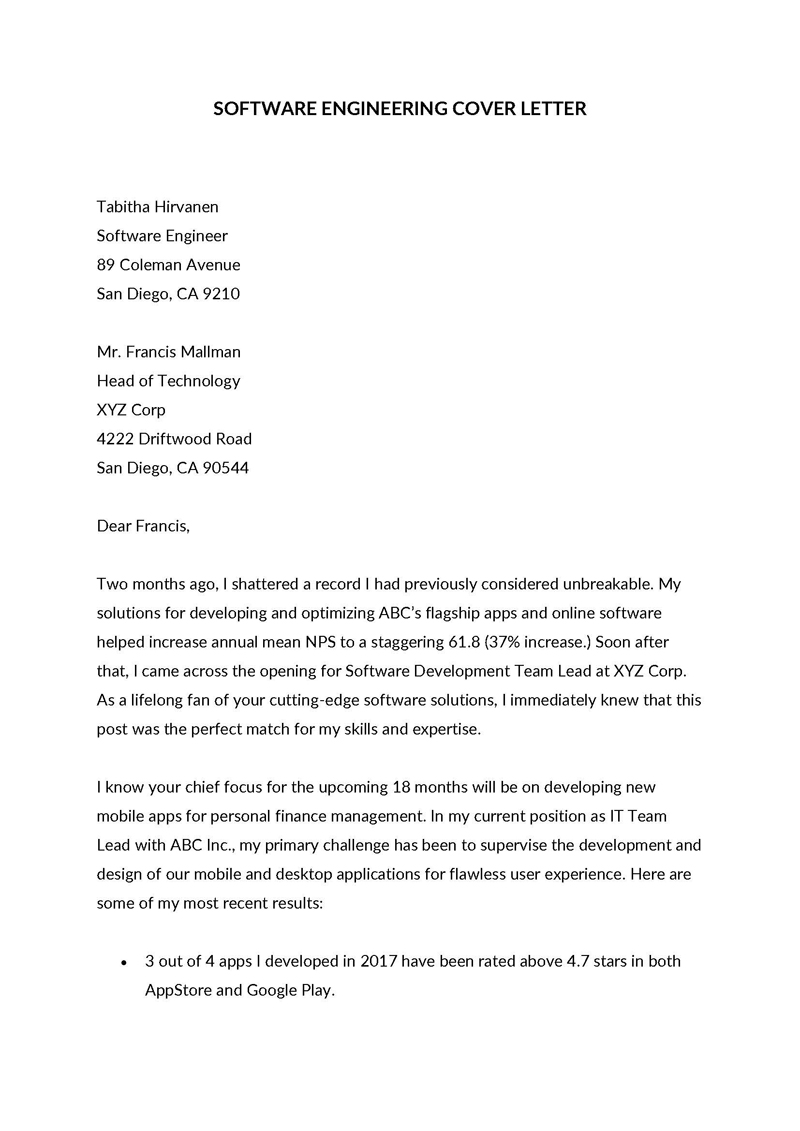
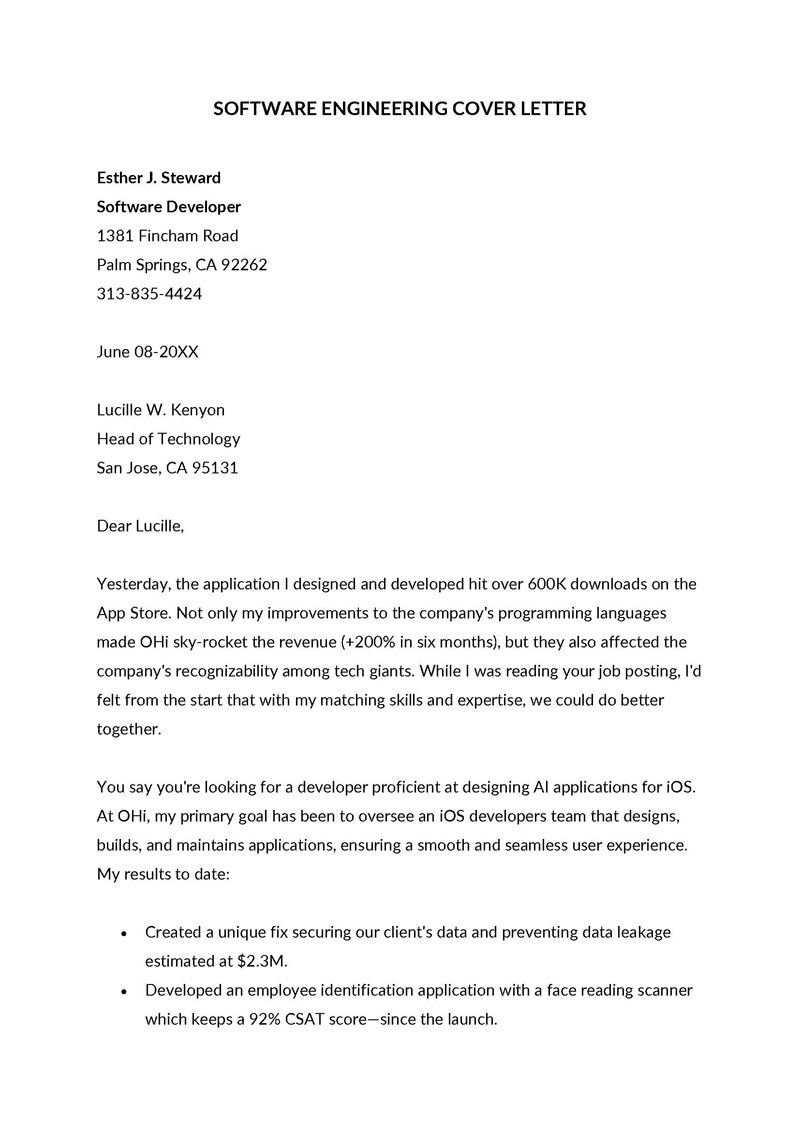
How to Write a Software Engineer Cover Letter
It is an official document that goes into the company’s record files if the applicant is hired. The letter should then be written in a formal format. Writing the perfect cover letter can play a huge role in securing you the job. It is therefore imperative to ensure you get this right. This article has outlined a few steps applicants can use to come up with a cover letter for a software engineer post that sets them apart from the rest.
The first item that should appear in the letter is the header. Like any formal letter, it must contain a header that identifies the sender and the recipient. You should therefore provide this information in the following manner:
Section 1: Include your personal information
Open the header by indicating your full name. This should then be followed up by the position you are applying for – software engineer. Contact information should also be provided. In a standard letter format, include the mailing address, then phone number and/or email address, LinkedIn, or website.
In an email format, the name and job title should be included in the subject line, and the hiring manager’s information is not included. Contact information is then provided after the email signature.
City and date
The cover letter ought to have the date when it was written and the applicant’s city of residence. The name of the city is declared in the mailing address. The date is provided after you have provided your information – state the day, month, and year.
Hiring manager’s details
The next information to write down is the potential employer’s details. If you do not know the hiring manager’s name, do some research and find out who is in charge of the recruitment process. Indicate their full name and their position in the company – hiring manager, human resources manager, chair of the hiring committee, etc. Next, write down the official name of the company and provide its official mailing address. The address should state the street address, city, and state ZIP code.
Section 2: Introduction
Once the header is appropriately written, the introduction can then be written. Consider incorporating the following information in the introduction:
Salutation
Provide a formal salutation. Start with “Dear,” followed by the recruiter’s name. Knowing the recruiter’s name will also come in handy in this section. Addressing the recruiter directly makes the cover letter more personal and shows the applicant did enough research, which can appeal to the recruiter’s personality.
Briefly introduce yourself and state your interest
After the salutation, introduce yourself to the recruiter. There are many ways to introduce yourself. You can state experience, outstanding skills, qualifications, impressive achievements, or the value you bring to the organisation. Select the best combination of information that will get the reader’s attention and inspire curiosity. Opt to include your interest in the position and knowledge of the company, such as their vision, mission, or slogan. The introduction should be just a few sentences long.
Section 3: Body
After the introduction, you have let the recruiter know who is writing the letter and for what reasons, it is time to demonstrate to them why you are suitable for the job. The body of the cover letter makes the largest section of the letter. It can be one or two paragraphs long. The body provides proof of why the recruiter should hire you and how you are prepared (professionally and personally) to take up the position.
It should be clear that you understand what is required of you and how you are prepared to meet those requirements by outlining the skills and experience you have that will help you in executing your assignments and responsibilities.
Highlight your software skills
Start by highlighting the software skills you possess. Software skills are a good starting point as they represent the bare minimum of why an applicant would be suitable for a software engineer position – without software skills, other qualifications might not be enough grounds for recruitment. Outline these skills in order of relevance to the job description. You can review the job description to have a better understanding of what to note down.
Examples of skills in software engineer you can list are:
- Statistical software – Apache, JSON
- Web tools – HTML, Google analytics
- Programming/web development – Python, JavaScript, PHP
Mention any relevant certifications that you have and how these skills have been previously used in your experience as a software engineer. Outline quantifiable achievements when illustrating the benefits the skills help you bring to the company.
Emphasise soft skills too
Next, outline your soft skills and how they are applicable in your line of work – software engineer. Soft skills are equally important to recruiters as hard skills. Soft skills illustrate how an applicant will be suitable for the company culture.
Examples of soft skills are:
- Communication skills – written and verbal
- Observant and fast learner
- Time management skills
- Leadership skills
You can also provide examples of situations where you have used the soft skills and achieved remarkable results in the execution of your duties.
note
Skills can simply be listed in bullet points.
Match your skills with job requirements
To finalise the body of the cover letter, match the mentioned qualifications, skills, and experiences to the job requirements. Again, consult the job description and research about the company. Highlight specific areas or challenges within the company where you would help the company with.
Section 4: Closing
The fourth step is to close off the letter. The closing should be written to incorporate the following details:
End with a polite closing statement
You can include a polite closing statement that reiterates that you are the perfect candidate for the job and you would be honoured if you were given the opportunity. Politeness goes a long way in any professional setting.
Call to action
Next, let the recruiter know you are available and interested in an interview. Make a formal request for them to get in touch. You can include your valid personal phone number or email at this point.
Thank the hiring manager/employer
Afterward, thank the recruiter for going through your cover letter. Recruiters will normally have to go through tons of applications; appreciating them for their efforts towards your application can go a long way in creating a positive impression.
Sign off
Then you should sign off the letter by providing a complimentary such as “Sincerely” followed by your signature and name. In an email format, the name will be sufficient.
Add a postscript
Lastly, attach evidence of an outstanding achievement you have had and declare that it would be your pleasure to talk about it and how you can replicate the same exemplary results in the company.
Tips for Writing an Effective Cover Letter
To further improve the efficiency of your cover letter, the following pro-writing tips can be implemented in the writing process:
Do your research
Research the company and align your cover letter to the company’s interests. Showing you understand what the company is trying to achieve and the challenges they are facing shows your interest in the software engineer position and the company, which are positives in the recruiter’s books.
Be specific and precise
Be specific when outlining information in the letter. When stating accomplishments and experiences, use statistical data to illustrate to describe the relevance of the information.
Personalise
As much as writing a cover letter is time-consuming, avoid reusing it. Create a different cover letter personalised to suit the company you are applying to. Information can be the same, but it does not have to be replicated word for word.
Quantify your skills
Use figures to quantify success or accomplishments. Numbers create interest and are easily understandable than long descriptions.
EXAMPLE
I designed a python based android and IOS application that shifted the company’s business model from brick-and-mortar to online sales. This resulted in a 500% increase in market reach and a 25% increase in sales for the year 2019. Another example, I introduced cloud sharing in Jets Associates that optimised information sharing with 95% efficiency. It increased the number of cases closed by a 40% margin and reduced supplies expenses from $50 000 to $25 000.
Use bullets
When listing key points, use bullet points. Bullet points are easily legible and easy to review.
Sample Letter (Email)
In the following section, we provide a practical example of a cover letter tailored for software engineer positions. This sample aims to serve as a helpful guide, offering insights into effective communication and presentation of skills in a professional setting
Subject: Application for Software Engineer Position
Dear Hiring Manager,
I am excited to apply for the software engineer position at Innovatech Solutions. With a bachelor’s degree in Computer Science and over three years of professional experience in software development, I am eager to bring my expertise to your team. My technical skills include advanced proficiency in Python, Java, and JavaScript, as well as a strong background in data structures and algorithms, essential for creating efficient and effective software solutions.
During my tenure at Digital Dynamics, I played a pivotal role in the design and implementation of a robust microservices architecture for a high-traffic web application. This involved using Docker for containerization and Kubernetes for orchestration, significantly improving the scalability and resilience of the system. I also implemented RESTful APIs and integrated several third-party services, enhancing the functionality and user experience of the application.
My commitment to continuous learning has led me to pursue advanced coursework in machine learning and cloud computing. This has equipped me with the skills to contribute to projects involving AI-driven features and cloud-based infrastructures. For instance, I recently developed a machine-learning model that improved the accuracy of our customer recommendation system by 25%. Additionally, my certification in AWS has enabled me to efficiently deploy and manage cloud-based applications, ensuring high availability and minimal downtime.
Innovatech Solutions’ reputation for innovation and excellence in software development is inspiring, and I am enthusiastic about the opportunity to contribute to your cutting-edge projects. I am particularly interested in your work on scalable cloud applications and AI, and I am eager to bring my background in these areas to your team. I am confident that my technical skills and passion for software engineering will make me a valuable addition to Innovatech Solutions.
Thank you for considering my application. I am looking forward to the opportunity to discuss how my technical skills and background align with the needs of your team. Please feel free to contact me at [your-email@email.com] or [555-123456] to arrange an interview.
Sincerely,
Maria Jones
Analysis
The letter presented here serves as an insightful guide for those seeking to craft a compelling cover letter for a software engineering position. One of its strengths lies in its structured format, which neatly organizes the content into four distinct paragraphs, each serving a specific purpose. The introduction effectively establishes the applicant’s background and intent, setting a professional tone.
What follows is a detailed exposition of the writer’s technical skills and experiences, specifically highlighting proficiency in programming languages such as Python, Java, and JavaScript and experience with Docker, Kubernetes, and AWS. This not only showcases the applicant’s technical acumen but also aligns their expertise with the needs of a modern software engineering role. The inclusion of tangible achievements, such as the development of a high-traffic web application and a machine learning model, adds credibility and demonstrates the impact of their work.
The letter concludes with a reaffirmation of the applicant’s interest in the role and an invitation for further discussion, which is a strategic move to encourage engagement from the employer. The formal tone, coupled with simple yet professional language, makes the letter accessible and appealing to a wide range of readers, serving as a valuable guide for crafting effective cover letters in the technology industry.
Letter Template
Following are some sample templates for your better understanding:
Template 1
[Your Name]
[Your Address]
[City, State, Zip Code]
[Telephone Contacts]
[Date]
[Hiring Manager’s Name]
[Company Address]
[City, State, Zip Code]
[Telephone Contacts]
Dear HR Manager,
Re: Applications for the position of Software Engineer
I am drafting this letter to express my interest in the position of Software Engineer with your company. Indeed, I am passionate about matters of software engineering. In particular, I am interested in all issues, design, programming, testing, and materialization of software programs.
Other than my raw interests, I am also widely known in the field of software engineering and development. I do hold a Diploma in Information Technology and a Bachelor’s Degree in Computer Science. Java, JavaScript, .Net, and Python Programming languages are my strongest points.
My past work entailed the following:
- Design, test, and development of the necessary software
- Data structures and algorithms
- Maintenance of the back-end sites
- Troubleshooting systems to see to it that they function optimally
Find enclosed in the envelope my resume, which contains a breakdown of all the skills and expertise I have to bring on board. Many thanks for your time and consideration. I seriously look forward to receiving an invitation to the interview.
Your Signature
Typed Name
Template 2
[Your name]
[Job Title]
[Street Address]
[City, State ZIP code]
[Date]
[Hiring manager’s name]
[Position]
[Company Name]
[Company Address]
[City, State ZIP code]
Dear [Hiring manager’s last name],
I’ve written this letter to express my interest in the software engineering job advertised on your website. I’ve been working as a software engineer at [Name of former employer] s for the past [number of years] years. It’d be an honor to share my extensive knowledge with your company if given the job.
After reviewing the posted job description, I am confident that I would execute the specified obligations satisfactorily. The following skills are some of the abilities I have in carrying out my duties as a software engineer:
- Skill one
- Skill two
- Skill three
I employed [skill] in propelling [former company] from a middle-sized enterprise to the well-known company that it is by boosting customer outreach from [number of customers] to [number of customers].
I am devoted to my work and a leader in my field. I pay attention to details, and I’m a results-driven software engineer who has an appetite for growth. [outline personal traits and soft skills]
I strongly believe my qualifications and experience will be a true asset to your organization. I take pride in my profession, and this job will be an opportunity for me to better myself and improve your company.
I am available for an interview, and should there be any further queries, you can reach me at [phone number and/or email address].
I sincerely thank you for going through my letter and hope you can go through my resume (attached).
Sincerely,
[Signature]
[Your full name]
Frequently Asked Questions
The cover letter should be long enough to communicate an applicant’s suitability for a job but no longer than necessary. As a result, cover letters for individuals with less experience will be shorter than those with more experience. For example, two years of experience can warrant a 200- or fewer-word cover letter, and a more experienced software engineer cannot exceed 300 words.
Start by creating a strong introduction that gets the recruiter’s attention and sparks curiosity, making them want to read more.
A standard software engineer cover letter should have the applicant’s details, the hiring manager and company details, a salutation, an introduction, a body, and a conclusion. The letter should outline the applicant’s skills, interest in the job, qualifications, experience, and achievements.












